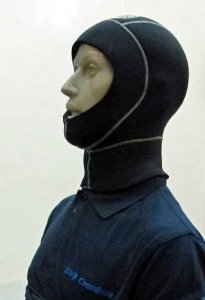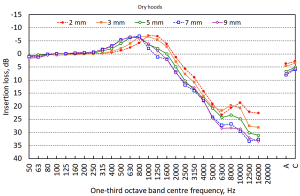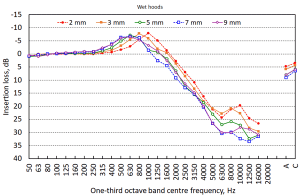Noise reduction of neoprene diving hoods in air

Diving hood on Kemar
People engaged in activities in or under open water normally wear some form of body protection such as a wetsuit to keep them warm. These activities could be work related (for example, repair and maintenance, sea rescue, archeology) or for recreation or sport (such as surfing and swimming). A separate neoprene hood is often worn to keep the head warm. Some divers who operate noisy machinery or tools in or underwater assume that hoods provide some protection from the noise while underwater, and may also provide some attenuation of the noise under dry conditions, when wearing a hood with their heads out of the water.
ISVR Consulting and the Institute of Naval Medicine measured the insertion losses, or noise reduction, of wet and dry neoprene hoods to airborne sound.
The insertion losses (noise reduction) of five neoprene diving hoods were measured in one-third octave bands using a Kemar manikin in a diffuse, broadband pink noise field in a reverberant chamber. The five hoods were from three suppliers and varied in thickness: 2 mm, 3 mm, 5 mm, 7 mm and 9 mm.
The insertion losses were measured first with the hoods dry and then with the hoods wetted by immersing them in water and allowing the excess water to drain away. Although the hood was wet, there was no water in the manikin’s ear canal.
Each measurement of an insertion loss involved five measurements of the sound levels at the manikin’s ears with the hood, interleaved with five measurements without the hood, so that the hood had to be fitted and removed five times. The mean insertion loss was then calculated as the sound level in each frequency band measured with the hood minus the corresponding sound level measured without the hood. The insertion loss is essentially the attenuation, but the term attenuation is usually reserved for noise reductions measured in real ear at threshold (REAT) tests with human listeners, whereas the insertion loss is applied when sound levels are measured, either on a manikin or with microphones in real ears (MIRE).
The mean measured insertion losses are shown in the two graphs, one for the dry hoods and one for the wet hoods.
The hoods, whether wet or dry, neither attenuated nor amplified sound below approximately 250 Hz. Between 315 Hz and 1 250 Hz, the insertion loss of each hood was negative, showing a broad resonance which amplified sound by around 6 dB to 8 dB at the maximum. In this frequency range a hood acts as a mass-spring system; in effect a hood stretched over the ears acts like a drum skin resonating in this frequency band.
Above 1 kHz or so, the insertion loss of each hood increased with frequency at around 10 dB per octave, reaching a maximum insertion loss at around 5 kHz to 8 kHz. Wetting each hood made very little difference to the insertion loss; the ‘drum-skin’ resonance frequency may be very marginally lower when the hood is wet, and the insertion losses may be marginally greater between around 1 kHz and 10 kHz, but any effects are very small.
The drum-skin resonance decreased in frequency with increasing thicknesses of hood, and the insertion loss at frequencies above the resonance, increased with the hood thickness.
The insertion losses can be used to calculate noise levels at the ears of a person wearing these hoods in air, though not underwater, when the one-third octave band spectrum and level of the ambient noise is known or can be estimated. The insertion loss in each one-third octave band is subtracted from the ambient external noise in that band to give the one-third octave band spectrum at the ear. The effective overall A-weighted noise level at the ear can then be calculated by A-weighting the bands and summing the values in each band. In the pink noise field used in these tests, the reduction in the A-weighted sound levels by the hoods was generally only between 4 dB and 9 dB. In most cases, a neoprene hood will provide very little reduction in airborne noise, and should not be relied upon to protect hearing.
For further details, see:
Attenuation of airborne noise by wet and dry neoprene diving hoods. G S Paddan (Institute of Naval Medicine) and M C Lower (ISVR Consulting). Underwater Technology 38(1), 3-12, March 2021. doi:10.3723/ut.38.003 ( pdf 2.8 MB).



